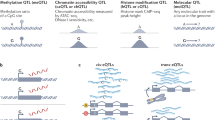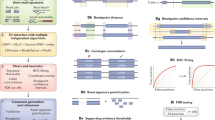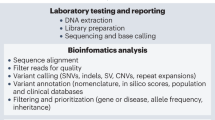Abstract
New technologies have recently enabled saturation mutagenesis and functional analysis of nearly all possible variants of regulatory elements or proteins of interest in single experiments. Here we discuss the past, present, and future of such multiplexed (functional) assays for variant effects (MAVEs). MAVEs provide detailed insight into sequence–function relationships, and they may prove critical for the prospective clinical interpretation of genetic variants.
This is a preview of subscription content, access via your institution
Access options
Subscribe to this journal
Receive 12 print issues and online access
$259.00 per year
only $21.58 per issue
Buy this article
- Purchase on Springer Link
- Instant access to full article PDF
Prices may be subject to local taxes which are calculated during checkout


Similar content being viewed by others
References
Botstein, D. & Shortle, D. Strategies and applications of in vitro mutagenesis. Science 229, 1193–1201 (1985).
Fowler, D.M. & Fields, S. Deep mutational scanning: a new style of protein science. Nat. Methods 11, 801–807 (2014).
Inoue, F. & Ahituv, N. Decoding enhancers using massively parallel reporter assays. Genomics 106, 159–164 (2015).
Cunningham, B. & Wells, J. High-resolution epitope mapping of hGH-receptor interactions by alanine-scanning mutagenesis. Science 244, 1081–1085 (1989).
Smith, G. Filamentous fusion phage: novel expression vectors that display cloned antigens on the virion surface. Science 228, 1315–1317 (1985).
Boder, E.T. & Wittrup, K.D. Yeast surface display for screening combinatorial polypeptide libraries. Nat. Biotechnol. 15, 553–557 (1997).
Amstutz, P. et al. In vitro selection for catalytic activity with ribosome display. J. Am. Chem. Soc. 124, 9396–9403 (2002).
Myers, R., Tilly, K. & Maniatis, T. Fine structure genetic analysis of a beta-globin promoter. Science 232, 613–618 (1986).
Cleary, M.A. et al. Production of complex nucleic acid libraries using highly parallel in situ oligonucleotide synthesis. Nat. Methods 1, 241–248 (2004).
Shendure, J. & Ji, H. Next-generation DNA sequencing. Nat. Biotechnol. 26, 1135–1145 (2008).
Ran, F.A. et al. Genome engineering using the CRISPR-Cas9 system. Nat. Protoc. 8, 2281–2308 (2013).
Jinek, M. et al. RNA-programmed genome editing in human cells. eLife 2, e00471 (2013).
Mali, P. et al. RNA-guided human genome engineering via Cas9. Science 339, 823–826 (2013).
Findlay, G.M., Boyle, E.A., Hause, R.J., Klein, J.C. & Shendure, J. Saturation editing of genomic regions by multiplex homology-directed repair. Nature 513, 120–123 (2014).
White, M.A. Understanding how cis-regulatory function is encoded in DNA sequence using massively parallel reporter assays and designed sequences. Genomics 106, 165–170 (2015).
Canver, M.C. et al. BCL11A enhancer dissection by Cas9-mediated in situ saturating mutagenesis. Nature 527, 192–197 (2015).
Wong, T.S., Roccatano, D., Zacharias, M. & Schwaneberg, U. A statistical analysis of random mutagenesis methods used for directed protein evolution. J. Mol. Biol. 355, 858–871 (2006).
Firnberg, E. & Ostermeier, M. PFunkel: efficient, expansive, user-defined mutagenesis. PLoS One 7, e52031 (2012).
Jain, P.C. & Varadarajan, R. A rapid, efficient, and economical inverse polymerase chain reaction-based method for generating a site saturation mutant library. Anal. Biochem. 449, 90–98 (2014).
McLaughlin, R.N. Jr., Poelwijk, F.J., Raman, A., Gosal, W.S. & Ranganathan, R. The spatial architecture of protein function and adaptation. Nature 491, 138–142 (2012).
Kitzman, J.O., Starita, L.M., Lo, R.S., Fields, S. & Shendure, J. Massively parallel single-amino-acid mutagenesis. Nat. Methods 12, 203–206 (2015).
Melnikov, A., Rogov, P., Wang, L., Gnirke, A. & Mikkelsen, T.S. Comprehensive mutational scanning of a kinase in vivo reveals substrate-dependent fitness landscapes. Nucleic Acids Res. 42, e112 (2014).
Naldini, L. et al. In vivo gene delivery and stable transduction of nondividing cells by a lentiviral vector. Science 272, 263–267 (1996).
Deyle, D.R. & Russell, D.W. Adeno-associated virus vector integration. Curr. Opin. Mol. Ther. 11, 442–447 (2009).
Craig, N.L. The mechanism of conservative site-specific recombination. Annu. Rev. Genet. 22, 77–105 (1988).
Sauer, B. Site-specific recombination: developments and applications. Curr. Opin. Biotechnol. 5, 521–527 (1994).
Patwardhan, R.P. et al. High-resolution analysis of DNA regulatory elements by synthetic saturation mutagenesis. Nat. Biotechnol. 27, 1173–1175 (2009).
Patwardhan, R.P. et al. Massively parallel functional dissection of mammalian enhancers in vivo. Nat. Biotechnol. 30, 265–270 (2012).
Ke, S. et al. Quantitative evaluation of all hexamers as exonic splicing elements. Genome Res. 21, 1360–1374 (2011).
Rosenberg, A.B., Patwardhan, R.P., Shendure, J. & Seelig, G. Learning the sequence determinants of alternative splicing from millions of random sequences. Cell 163, 698–711 (2015).
Kinney, J.B., Murugan, A., Callan, C.G. Jr. & Cox, E.C. Using deep sequencing to characterize the biophysical mechanism of a transcriptional regulatory sequence. Proc. Natl. Acad. Sci. USA 107, 9158–9163 (2010).
Sharon, E. et al. Inferring gene regulatory logic from high-throughput measurements of thousands of systematically designed promoters. Nat. Biotechnol. 30, 521–530 (2012).
Fowler, D.M. et al. High-resolution mapping of protein sequence–function relationships. Nat. Methods 7, 741–746 (2010).
Starita, L.M. et al. Activity-enhancing mutations in an E3 ubiquitin ligase identified by high-throughput mutagenesis. Proc. Natl. Acad. Sci. USA 110, E1263–E1272 (2013).
Whitehead, T.A. et al. Optimization of affinity, specificity and function of designed influenza inhibitors using deep sequencing. Nat. Biotechnol. 30, 543–548 (2012).
Stiffler, M.A., Hekstra, D.R. & Ranganathan, R. Evolvability as a function of purifying selection in TEM-1 b-lactamase. Cell 160, 882–892 (2015).
Deng, Z. et al. Deep sequencing of systematic combinatorial libraries reveals b-lactamase sequence constraints at high resolution. J. Mol. Biol. 424, 150–167 (2012).
Melamed, D., Young, D.L., Miller, C.R. & Fields, S. Combining natural sequence variation with high throughput mutational data to reveal protein interaction sites. PLoS Genet. 11, e1004918 (2015).
Kim, I., Miller, C.R., Young, D.L. & Fields, S. High-throughput analysis of in vivo protein stability. Mol. Cell. Proteomics 12, 3370–3378 (2013).
Hietpas, R.T., Jensen, J.D. & Bolon, D.N. Experimental illumination of a fitness landscape. Proc. Natl. Acad. Sci. USA 108, 7896–7901 (2011).
Thyagarajan, B. & Bloom, J.D. The inherent mutational tolerance and antigenic evolvability of influenza hemagglutinin. eLife 3, 1–26 (2014).
Doud, M.B., Ashenberg, O. & Bloom, J.D. Site-specific amino acid preferences are mostly conserved in two closely related protein homologs. Mol. Biol. Evol. 32, 2944–2960 (2015).
Bloom, J.D. An experimentally determined evolutionary model dramatically improves phylogenetic fit. Mol. Biol. Evol. 31, 1956–1978 (2014).
Doolan, K.M. & Colby, D.W. Conformation-dependent epitopes recognized by prion protein antibodies probed using mutational scanning and deep sequencing. J. Mol. Biol. 427, 328–340 (2015).
Starita, L.M. et al. Massively parallel functional analysis of BRCA1 RING domain variants. Genetics 200, 413–422 (2015).
Green, R.C. et al. ACMG recommendations for reporting of incidental findings in clinical exome and genome sequencing. Genet. Med. 15, 565–574 (2013).
Hiatt, J.B., Patwardhan, R.P., Turner, E.H., Lee, C. & Shendure, J. Parallel, tag-directed assembly of locally derived short sequence reads. Nat. Methods 7, 119–122 (2010).
Bloom, J.D. Software for the analysis and visualization of deep mutational scanning data. BMC Bioinformatics 16, 168 (2015).
Fowler, D.M., Araya, C.L., Gerard, W. & Fields, S. Enrich: software for analysis of protein function by enrichment and depletion of variants. Bioinformatics 27, 3430–3431 (2011).
Matuszewski, S., Hildebrandt, M.E., Ghenu, A.-H., Jensen, J.D. & Bank, C. A statistical guide to the design of deep mutational scanning experiments. Preprint at http://biorxiv.org/content/early/2016/06/29/048892 (2016).
Ireland, W.T. & Kinney, J.B. Sort-Seq Tools: sequence-function relationship modeling for massively parallel assays. Preprint at http://biorxiv.org/content/early/2016/05/21/054676 (2016).
White, M.A., Myers, C.A., Corbo, J.C. & Cohen, B.A. Massively parallel in vivo enhancer assay reveals that highly local features determine the cis-regulatory function of ChIP-seq peaks. Proc. Natl. Acad. Sci. USA 110, 11952–11957 (2013).
Majithia, A.R. et al. Rare variants in PPARG with decreased activity in adipocyte differentiation are associated with increased risk of type 2 diabetes. Proc. Natl. Acad. Sci. USA 111, 13127–13132 (2014).
Exome Aggregation Consortium. Analysis of protein-coding genetic variation in 60,706 humans. Nature 536, 285–291 (2016).
Landrum, M.J. et al. ClinVar: public archive of interpretations of clinically relevant variants. Nucleic Acids Res. 44, D862–D868 (2016).
ENCODE Project Consortium. An integrated encyclopedia of DNA elements in the human genome. Nature 489, 57–74 (2012).
Ardlie, K.G. et al. The Genotype-Tissue Expression (GTEx) pilot analysis: multitissue gene regulation in humans. Science 348, 648–660 (2015).
Welter, D. et al. The NHGRI GWAS Catalog, a curated resource of SNP-trait associations. Nucleic Acids Res. 42, D1001–D1006 (2014).
Xiong, H.Y. et al. The human splicing code reveals new insights into the genetic determinants of disease. Science 347, 1254806 (2015).
Maxwell, K.N. et al. Evaluation of ACMG-guideline-based variant classification of cancer susceptibility and non-cancer-associated genes in families affected by breast cancer. Am. J. Hum. Genet. 98, 801–817 (2016).
Vockley, C.M. et al. Massively parallel quantification of the regulatory effects of noncoding genetic variation in a human cohort. Genome Res. 25, 1206–1214 (2015).
Tewhey, R. et al. Direct identification of hundreds of expression-modulating variants using a multiplexed reporter assay. Cell 165, 1519–1529 (2016).
Ulirsch, J.C. et al. Systematic functional dissection of common genetic variation affecting red blood cell traits. Cell 165, 1530–1545 (2016).
Rich, M.S. et al. Comprehensive analysis of the SUL1 promoter of Saccharomyces cerevisiae. Genetics 203, 191–202 (2016).
Melnikov, A. et al. Systematic dissection and optimization of inducible enhancers in human cells using a massively parallel reporter assay. Nat. Biotechnol. 30, 271–277 (2012).
Kwasnieski, J.C., Mogno, I., Myers, C.A., Corbo, J.C. & Cohen, B.A. Complex effects of nucleotide variants in a mammalian cis-regulatory element. Proc. Natl. Acad. Sci. USA 109, 19498–19503 (2012).
Birnbaum, R.Y. et al. Systematic dissection of coding exons at single nucleotide resolution supports an additional role in cell-specific transcriptional regulation. PLoS Genet. 10, e1004592 (2014).
Holmqvist, E., Reimegård, J. & Wagner, E.G.H. Massive functional mapping of a 5-UTR by saturation mutagenesis, phenotypic sorting and deep sequencing. Nucleic Acids Res. 41, e122 (2013).
Dvir, S. et al. Deciphering the rules by which 5-UTR sequences affect protein expression in yeast. Proc. Natl. Acad. Sci. USA 110, E2792–E2801 (2013).
Shalem, O. et al. Systematic dissection of the sequence determinants of gene 3 end mediated expression control. PLoS Genet. 11, e1005147 (2015).
Procko, E. et al. Computational design of a protein-based enzyme inhibitor. J. Mol. Biol. 425, 3563–3575 (2013).
Lind, P.A., Berg, O.G. & Andersson, D.I. Mutational robustness of ribosomal protein genes. Science 330, 825–827 (2010).
Podgornaia, A.I. & Laub, M.T. Pervasive degeneracy and epistasis in a protein-protein interface. Science 347, 673–677 (2015).
Pál, G., Kouadio, J.L.K., Artis, D.R., Kossiakoff, A.A. & Sidhu, S.S. Comprehensive and quantitative mapping of energy landscapes for protein-protein interactions by rapid combinatorial scanning. J. Biol. Chem. 281, 22378–22385 (2006).
Sarkisyan, K.S. et al. Local fitness landscape of the green fluorescent protein. Nature 533, 397–401 (2016).
Adkar, B.V. et al. Protein model discrimination using mutational sensitivity derived from deep sequencing. Structure 20, 371–381 (2012).
Roscoe, B.P., Thayer, K.M., Zeldovich, K.B., Fushman, D. & Bolon, D.N.A. Analyses of the effects of all ubiquitin point mutants on yeast growth rate. 425, 1363–1377 (2013).
Forsyth, C.M. et al. Deep mutational scanning of an antibody against epidermal growth factor receptor using mammalian cell display and massively parallel pyrosequencing. MAbs 5, 523–532 (2013).
Van Blarcom, T. et al. Precise and efficient antibody epitope determination through library design, yeast display and next-generation sequencing. J. Mol. Biol. 427, 1513–1534 (2015).
Shin, H. et al. Exploring the functional residues in a flavin-binding fluorescent protein using deep mutational scanning. PLoS One 9, e97817 (2014).
Gajula, K.S. et al. High-throughput mutagenesis reveals functional determinants for DNA targeting by activation-induced deaminase. Nucleic Acids Res. 42, 9964–9975 (2014).
Acknowledgements
The authors thank the Shendure lab, and in particular R. Hause, for discussions. M.G. is a National Science Foundation Graduate Research Fellow. J.S. is an Investigator of the Howard Hughes Medical Institute.
Author information
Authors and Affiliations
Contributions
M.G., L.S., and J.S. prepared the manuscript.
Corresponding author
Ethics declarations
Competing interests
The authors declare no competing financial interests.
Rights and permissions
About this article
Cite this article
Gasperini, M., Starita, L. & Shendure, J. The power of multiplexed functional analysis of genetic variants. Nat Protoc 11, 1782–1787 (2016). https://doi.org/10.1038/nprot.2016.135
Received:
Accepted:
Published:
Issue Date:
DOI: https://doi.org/10.1038/nprot.2016.135
This article is cited by
-
Leveraging massively parallel reporter assays for evolutionary questions
Genome Biology (2023)
-
Using Synthetic DNA Libraries to Investigate Chromatin and Gene Regulation
Chromosoma (2023)
-
Mycobacterium abscessus pathogenesis identified by phenogenomic analyses
Nature Microbiology (2022)
-
Integrating thousands of PTEN variant activity and abundance measurements reveals variant subgroups and new dominant negatives in cancers
Genome Medicine (2021)
-
Overcoming the design, build, test bottleneck for synthesis of nonrepetitive protein-RNA cassettes
Nature Communications (2021)
Comments
By submitting a comment you agree to abide by our Terms and Community Guidelines. If you find something abusive or that does not comply with our terms or guidelines please flag it as inappropriate.



